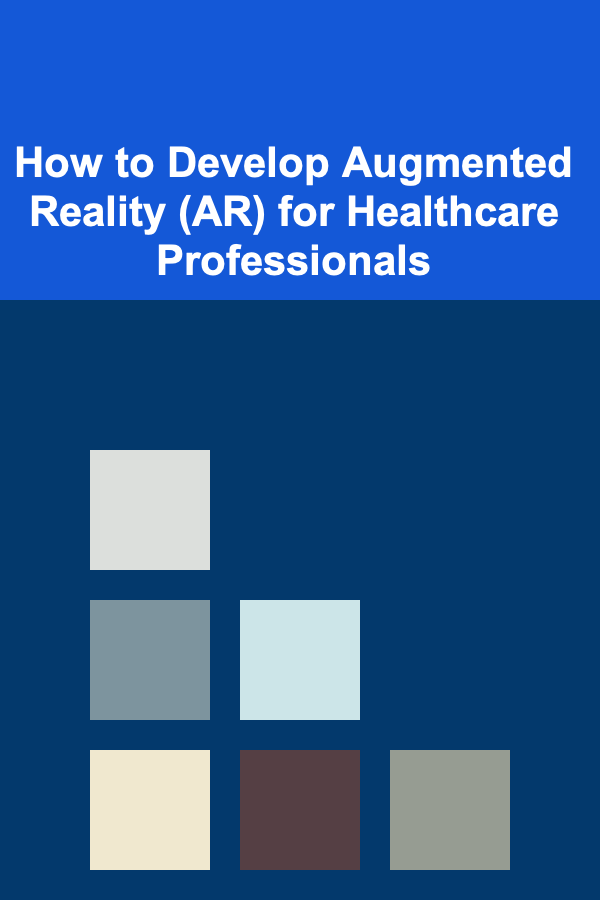
How to Develop Augmented Reality (AR) for Healthcare Professionals
ebook include PDF & Audio bundle (Micro Guide)
$12.99$11.99
Limited Time Offer! Order within the next:

Augmented Reality (AR) has emerged as one of the most promising technologies in healthcare, offering new ways to enhance patient care, improve medical education, and support healthcare professionals in their daily tasks. From assisting with complex surgeries to enabling immersive training for medical students, AR is transforming the healthcare industry in ways that were once considered science fiction. However, the development of AR applications for healthcare professionals is not a straightforward process. It requires a deep understanding of both healthcare needs and AR technology, as well as the ability to bridge the gap between these two complex fields.
In this article, we will explore the steps involved in developing AR for healthcare professionals, covering the technical, ethical, and practical considerations that must be addressed. From conceptualization and design to implementation and evaluation, we will provide a comprehensive guide for anyone interested in creating AR solutions that can make a tangible impact on healthcare practice.
Understanding the Role of AR in Healthcare
Before diving into the development process, it's essential to understand the role that AR can play in healthcare. AR is a technology that overlays digital information (such as images, sounds, or text) onto the real world, creating an interactive experience that enhances a user's perception of their environment. In the context of healthcare, AR can be used in various ways:
- Medical Training and Education: AR allows students and medical professionals to engage in interactive, 3D simulations of human anatomy, surgical procedures, and medical conditions. This type of learning is more immersive and engaging compared to traditional textbook-based methods.
- Surgical Assistance: Surgeons can use AR to visualize critical anatomical structures during surgery, improving accuracy and reducing the risk of errors. For instance, AR can superimpose images from MRI or CT scans directly onto a patient's body during a procedure, guiding the surgeon in real-time.
- Diagnostics and Imaging: AR can enhance diagnostic accuracy by overlaying medical imaging (such as X-rays or MRIs) onto the patient's body, allowing healthcare professionals to see the problem areas more clearly and make more informed decisions.
- Patient Care: AR can assist with patient care by providing real-time information and visual guidance for healthcare providers. For example, AR could help nurses administer medications by overlaying dosage instructions directly onto a patient's medication chart.
Key Steps in Developing AR for Healthcare Professionals
Developing AR applications for healthcare professionals requires careful planning, the right tools, and a multidisciplinary approach. Here are the key steps involved in the development process:
Step 1: Define the Use Case and Objectives
The first step in developing AR for healthcare is to define the specific use case or problem that the application will address. This involves understanding the healthcare needs of the professionals who will use the AR application and identifying how AR can enhance their work. Key questions to consider include:
- Who is the target audience? Are you developing AR for surgeons, medical students, nurses, or general practitioners? Different healthcare professionals have different needs and workflows, and your AR solution should cater to those specific needs.
- What is the primary goal? Are you aiming to improve training, enhance diagnostics, assist with surgeries, or provide patient care? The goals will dictate the design and features of your AR application.
- What are the pain points? Identify the challenges or inefficiencies that healthcare professionals face in their daily work and consider how AR can alleviate those problems. For example, in surgery, AR might help with spatial awareness, while in training, it might improve hands-on experience.
Once the objectives are clear, it's crucial to validate the use case with healthcare professionals to ensure that the technology will meet their needs and solve real-world problems.
Step 2: Research and Select the Right AR Platform
There are a variety of AR platforms available, and selecting the right one depends on the specific requirements of the application. Key factors to consider include:
- Hardware Compatibility: AR applications require specialized hardware, such as smartphones, tablets, or AR glasses (like Microsoft HoloLens or Magic Leap). The choice of hardware will depend on factors such as mobility, user preferences, and the complexity of the AR experience.
- Software Development Kits (SDKs): Platforms such as Unity, Vuforia, ARKit (for iOS), and ARCore (for Android) provide robust tools for building AR applications. These SDKs offer features like 3D rendering, tracking, and spatial mapping, which are essential for AR development.
- Cloud Computing and Data Integration: Healthcare applications often require access to large datasets, such as medical records, images, and diagnostic information. AR applications should be able to seamlessly integrate with cloud-based healthcare systems (e.g., Electronic Health Records or EHR systems) to pull and display relevant information in real-time.
- User Experience (UX) Design: The interface and user experience are critical in healthcare, as professionals need to focus on their tasks without being distracted by complicated technology. Intuitive controls, simple navigation, and minimalistic designs are crucial.
Step 3: Collaborate with Healthcare Professionals
Developing AR for healthcare is not a process that can be done in isolation. Close collaboration with healthcare professionals is necessary to ensure that the application is functional, effective, and tailored to real-world needs. This collaboration should involve:
- Feedback Loops: Healthcare professionals should provide continuous feedback during the development process. This ensures that the AR application is practical and meets the users' expectations.
- Clinical Trials and Testing: Before deploying an AR solution, it is essential to conduct clinical trials or user testing with healthcare professionals to identify potential issues and refine the application. Testing should focus on usability, effectiveness, and safety.
- Cross-disciplinary Teams: AR development for healthcare requires input from experts in various fields, including healthcare professionals, software developers, designers, and regulatory specialists. Working in cross-disciplinary teams ensures that all aspects of the application are considered.
Step 4: Design and Prototype the AR Experience
Once the requirements are clear and the platform has been selected, the next step is to design the AR experience. This phase involves:
- User-Centered Design: The design should prioritize the needs of the healthcare professionals who will use the application. The user interface (UI) should be simple, intuitive, and easy to interact with during high-stress situations, such as in a surgery or emergency scenario.
- 3D Modeling and Visualization: Medical AR applications often involve the visualization of complex anatomical structures. High-quality 3D models of human organs, tissues, and other structures are essential for delivering accurate and realistic AR experiences.
- Prototyping: Building a prototype is essential to visualize how the AR application will function in real-world settings. The prototype should allow for testing and feedback from healthcare professionals to identify areas for improvement before full-scale development.
Step 5: Develop the AR Application
After the design phase, the development process can begin. This involves coding the application, integrating it with the necessary hardware, and ensuring that it functions smoothly. Key considerations during development include:
- Real-Time Tracking: AR applications rely on real-time tracking of the user's environment. In healthcare, this might include tracking the patient's body or surgical instruments. Ensuring high accuracy in tracking is critical to prevent errors in medical applications.
- Data Integration: The AR application must integrate seamlessly with existing healthcare systems (e.g., Electronic Health Records, diagnostic tools, etc.). This integration allows healthcare professionals to access patient data and imaging directly within the AR interface.
- Security and Privacy: Healthcare applications must comply with strict regulations like HIPAA (Health Insurance Portability and Accountability Act) in the United States, which governs the security and privacy of patient data. Ensuring that patient information is secure and that the application is compliant with relevant laws is paramount.
Step 6: Testing and Iteration
Once the AR application is developed, it needs to undergo rigorous testing to ensure that it works as intended. This includes:
- User Testing: Involve healthcare professionals in testing the application to ensure it meets their needs and is user-friendly. This can include testing the application in real-world scenarios, such as mock surgeries or clinical environments.
- Performance Testing: AR applications are resource-intensive, and performance is critical, especially when dealing with real-time data and 3D visualizations. Testing the application on the target hardware is essential to ensure it runs smoothly.
- Clinical Validation: Before deploying the AR solution in a clinical environment, it must undergo clinical validation to ensure that it enhances medical practice and improves patient outcomes.
Step 7: Deployment and Post-Launch Support
After thorough testing, the AR application can be deployed in healthcare settings. However, the development process doesn't end there:
- Ongoing Support and Updates: Healthcare needs evolve over time, and the AR application may need updates to incorporate new medical guidelines, technologies, or feedback from users.
- Training and Education: Healthcare professionals must be trained on how to use the AR system effectively. This could involve workshops, online tutorials, and support materials.
- Monitoring and Evaluation: Post-launch monitoring is essential to evaluate the effectiveness of the AR application. Regular assessments can help identify areas for improvement and ensure that the application continues to meet the needs of healthcare professionals.
Challenges and Ethical Considerations
While AR holds immense potential in healthcare, there are several challenges and ethical considerations that must be addressed:
- Data Privacy: Healthcare applications must adhere to stringent data privacy regulations. Ensuring the confidentiality and security of patient information is critical when developing AR solutions.
- Safety: In medical applications, the accuracy and reliability of AR systems are paramount. Any errors in the AR visualization could lead to misdiagnoses or surgical mistakes.
- Adoption Barriers: Healthcare professionals may be resistant to adopting new technologies, especially in high-pressure environments. Overcoming this resistance through training, support, and clear demonstrations of value is essential for successful AR implementation.
- Cost: Developing and implementing AR technology can be expensive. However, the long-term benefits of improved patient care and medical training can offset the initial investment.
Conclusion
Developing AR applications for healthcare professionals is a complex yet rewarding process that requires a thorough understanding of both the technology and the healthcare industry. By focusing on the needs of healthcare professionals, selecting the right AR platform, and ensuring rigorous testing and validation, developers can create solutions that have a meaningful impact on patient care, medical education, and healthcare efficiency. As AR technology continues to advance, its potential to revolutionize healthcare will only grow, making it an exciting field for developers and healthcare professionals alike.

How to Build a Passive Income Portfolio Using Deep Learning
Read More
How to Choose the Right Storage Solutions for Pet Toys
Read More
How to Organize and Save Space in a Small Closet
Read More
How to Organize Your Digital Devices and Save Space at Home
Read More
The Generous Partner: Giving and Receiving Love Freely
Read More
Printing with Soluble Supports: A Comprehensive Guide
Read MoreOther Products

How to Build a Passive Income Portfolio Using Deep Learning
Read More
How to Choose the Right Storage Solutions for Pet Toys
Read More
How to Organize and Save Space in a Small Closet
Read More
How to Organize Your Digital Devices and Save Space at Home
Read More
The Generous Partner: Giving and Receiving Love Freely
Read More